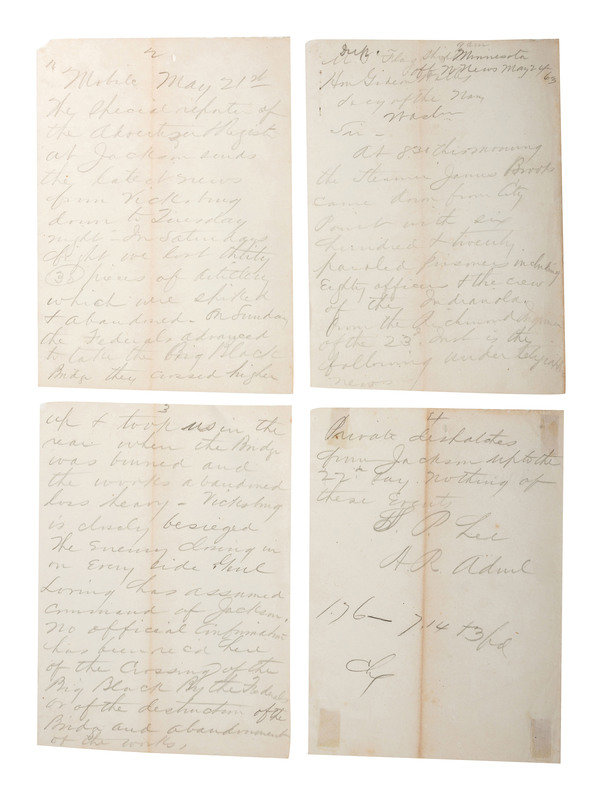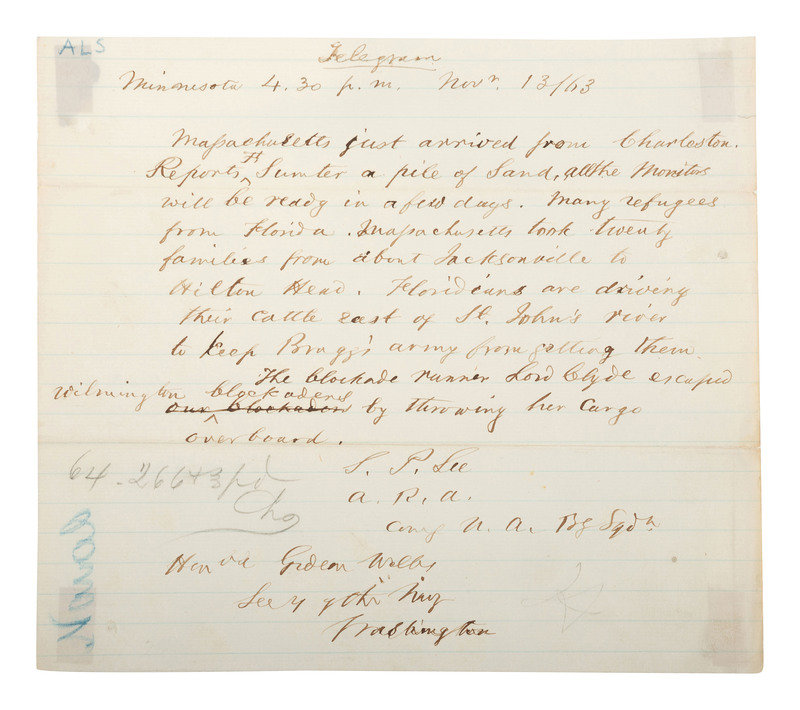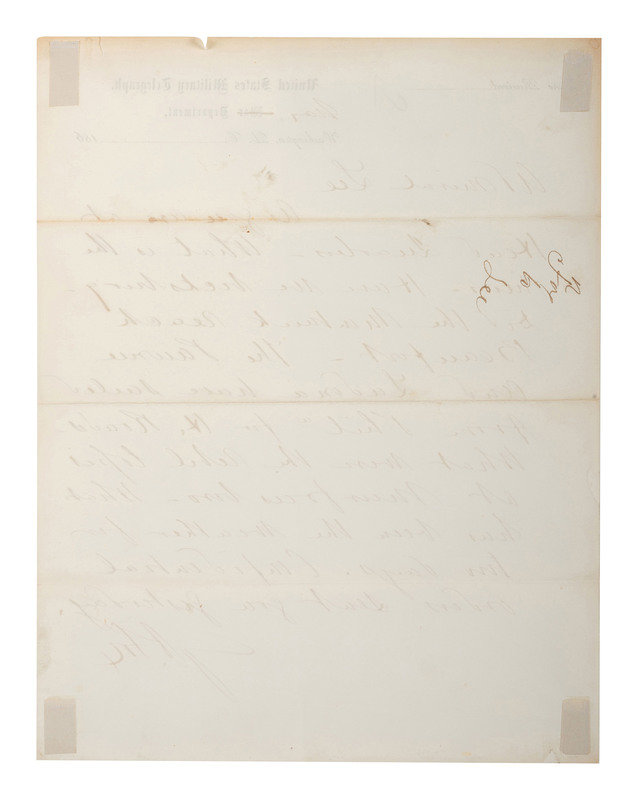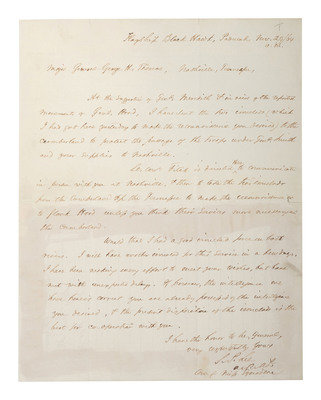Lot 524
[CIVIL WAR - US NAVY]. LEE, Samuel Phillips (1812-1897). A group of 7 documents related to Rear Admiral Samuel P. Lee, incl. Vicksburg content and preparations for the Battle of Nashville.
Sale 960 - American Historical Ephemera & Photography
Nov 15, 2021
11:00AM ET
Live / Cincinnati
Own a similar item?
Estimate
$800 -
1,200
Price Realized
$875
Sold prices are inclusive of Buyer’s Premium
Lot Description
[CIVIL WAR - US NAVY]. LEE, Samuel Phillips (1812-1897). A group of 7 documents related to Rear Admiral Samuel P. Lee, incl. Vicksburg content and preparations for the Battle of Nashville.
Autograph letter signed ("S.P. Lee") as Acting Rear Admiral, to Asst. Sec. of the Navy, Gustavus V. Fox, from U. S. Flag Ship Minnesota, Newport News, 10 January 1863. 1 p., 8vo (light soil, blue pencil upper left corner). Reads in full: “Flag of Truce arrived at noon without news from Vicksburg: another boat expected down this evening has not arrived. / The Richmond Enquirer of the 9th contains a new order for Conscripts. / Weather Easterly – Ironsides leaves tomorrow."
Letter signed ("S.P. Lee") as Acting Rear Admiral, Commanding North Atlantic Blockading Squadron, to Secretary of the Navy Gideon Welles, from U. S. Flag Ship Minnesota, 13 November 1863. ½ p., 4to (light soil, pencil marks, adhesive residue on verso). The text of a telegram to Welles reads: “Massachusetts just arrived from Charleston. Reports Ft. Sumter a pile of sand, all the Monitors will be ready in a few days. Many refugees from Florida. Massachusetts took twenty families from about Jacksonville to Hilton Head. Floridians are driving their cattle east of St. John’s River to keep Bragg’s army from getting them. / The blockade runner Lord Clyde escaped Wilmington Blockaders by throwing her cargo over board.”
Autograph letter signed ("S.P. Lee") as Acting Rear Admiral, Commanding Mississippi Squadron, from Flagship Black Hawk in Paducah, Kentucky, to Major General George H. Thomas in Nashville, 29 November 1864. 1 p., 4to (light soil, residue on verso). Lee writes that he has sent two ironclads to the Cumberland to conduct the reconnaissance regarding the reported movements of Gen. Hood as Thomas requested, and “to protect the passage of troops under Gen. Smith and your supplies to Nashville.” He bemoans the shortage of ironclads at his disposal and the consequent delay in addressing Thomas’s needs. However, he understands that Thomas may already have the intelligence he needs, in which case the two ironclads are better off where they are. Earlier in the year, Forrest had conducted two successful raids on Paducah, which served as a major Union supply depot throughout the war. Though Nashville had fallen to the Union in February 1862, this letter refers to preparations for the Battle of Nashville on 15 – 16 December 1864, a decisive Union victory.
[With:]
Text in unknown hand for a telegram from Acting Rear Admiral Lee to Gideon Welles, from aboard the Flag Ship Minnesota off Newport News, 24 May 1863. 4pp, 8vo, pencil (toned especially at center fold). Telegram indicates that the steamer James Brooks came down from City Point with 620 paroled prisoners including eight officers “& the crew of the Indianola from the Richmond [indecipherable word]. Of the 23rd Inst is the following under telegraph news. ‘Mobile May 21st / the special reporter of the Advertiser and Register at Jackson sends this latest news from Vicksburg down to Tuesday night. ‘In Saturday’s fight we lost thirty (30) pieces of artillery which we [indecipherable word] and abandoned. On Sunday the Federals advanced to take the Big Black Bridge[.] they crossed higher up and took us in the rear when the bridge was burned and the works abandoned[.] loss heavy – Vicksburg is closely[?] besieged the enemy closing in on every side[.] General Loring has assumed command of Jackson.[’] No official information has been rec’d here of the Crossing of the Big Black by the Federals or of the destruction of the Bridge and abandonment of the works. Private dispatched from Jackson up to the 22nd say nothing of these events.”
Two documents from Gustavus V. Fox to Lee. One a copy of the text of a telegraph to Lee at Newport News, 1 November 1863, 1p., 8vo (adhesive residue on verso, letterhead of the U. S. Military Telegraph the printed heading having been excised). “Keep the Sangamon until further orders—on receipt of your written confidential dispatch it was read to General Halleck who disapproved of the movement of Major General Foster and this Department supposed it was abandoned. . . .” The second a letter signed ("G.V. Fox") to “Admiral Lee” on the letterhead of the “United States Military Telegraph,” n.d. 1 p. 4to, (light soil, adhesive residue on verso). The text of a telegram: “As you are at Head Quarters, what is the news—have we Vicksburg, did the Montauk reach Beaufort—the Pawnee and Landona have sailed from Phila for H. Roads-what were the Rebel losses at Murphreesboro—What has been the weather for two days. Confidential orders sent you yesterday.”
Autograph letter signed ("H.A. Wise") as Acting Chief Bursar, to "Admiral Lee. U.S.N. / Fortress Monroe," 4 July [1862]. 1p, 8 x 10 in. (toning, adhesive residue on verso). Text of a telegram in which Wise quotes at length from a detailed report provided by a “refugee”: “I left Richmond on the 27th of June and came off from the Virginia shore to the mortar guard vessel at Piney Point yesterday. The steamer [‘]Jamestown’ now the ‘Patrick Henry’ is lying in James River at Drury’s [sic, Drewry’s] Bluff ready for sea, and will try to get out. She mounts six or seven guns and the Rebels feel confident she can get out of the Roads. The vessel is fitted as a privateer and her charts were put on board the 25th June.” Actually, the CSS Yorktown, not its sister ship the Jamestown, was renamed the Patrick Henry. This report does not appear to fit exactly the movements of either the Jamestown or the Patrick Henry, though both spent time on the James River at Drewry’s Bluff. The Jamestown is eliminated from consideration because it was sunk to obstruct the channel on May 15, 1862, almost a month before the above events reported by the refugee.
Born in Virginia, Samuel P. Lee was a third cousin to Robert E. Lee, and staunch supporter of the Union. He was appointed a midshipman in the US Navy in 1825. By the outbreak of the Civil War he held the rank of commander. After first participating in the New Orleans campaign as part of the West Gulf Blockading Squadron, Lee was placed in command of the North Atlantic Blockading Squadron in September 1862 then commanded the Mississippi Squadron from October 1864 until the end of the war. He retired from active service in 1873 having attained the rank of Rear Admiral.
The Richard B. Cohen Civil War Collection
Condition Report
Contact Information
Auction Specialist



















